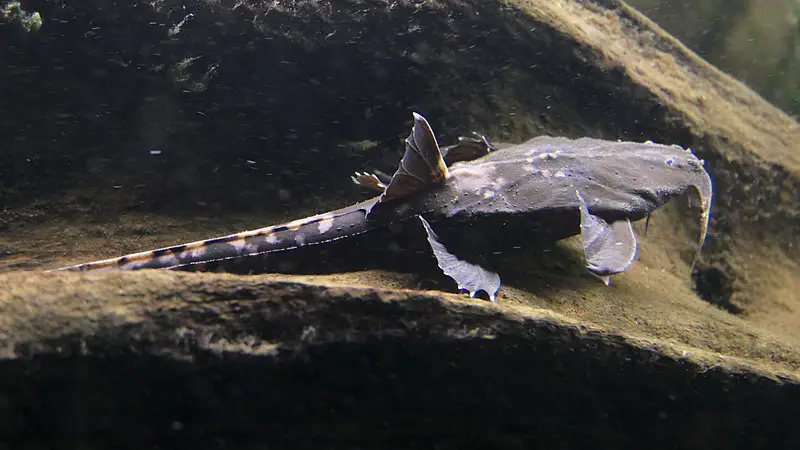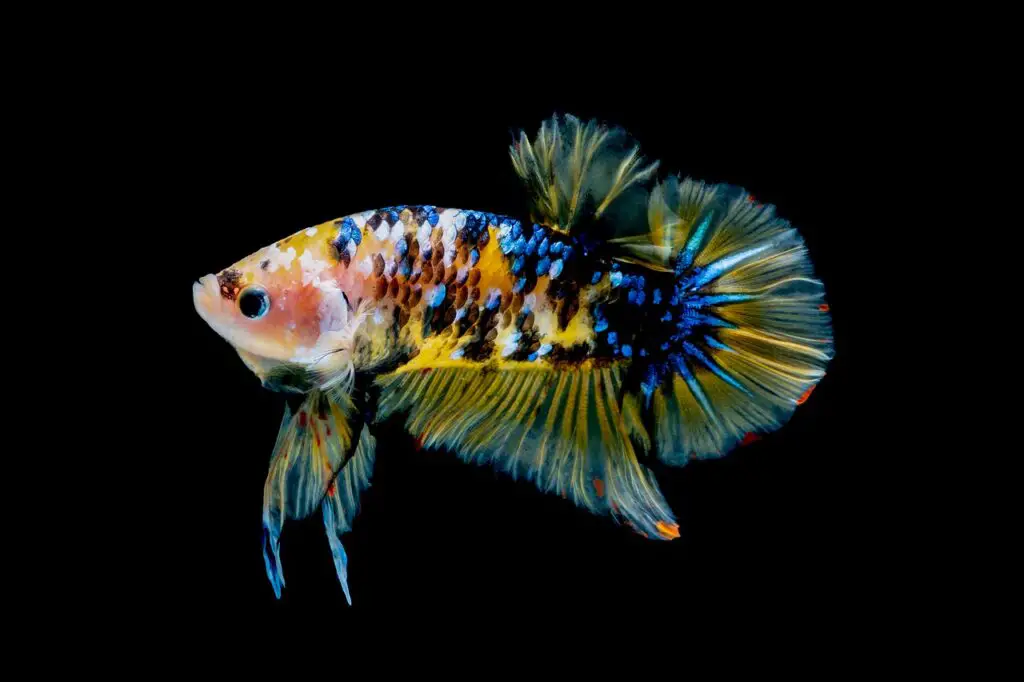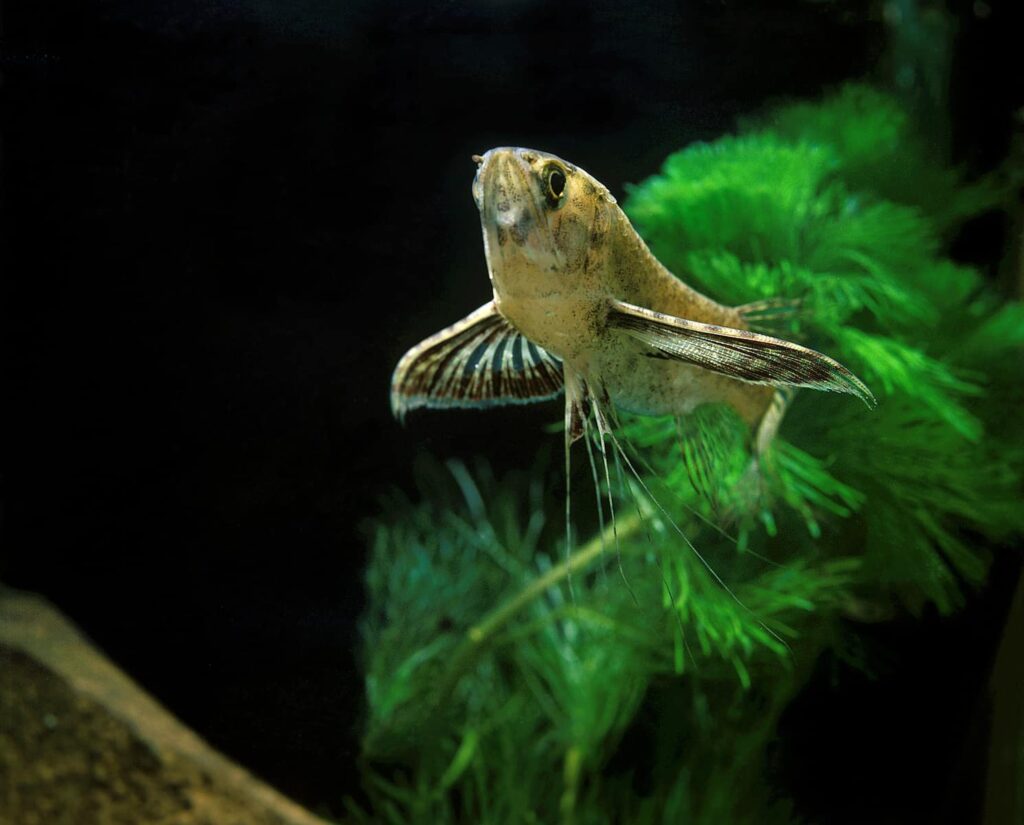The Asian banjo catfish, scientifically known as Acrochordonichthys rugosus, is a unique fish native to the forest streams of Indonesia, Malaysia, and Thailand. With a wide range of colors and a distinctive shape, the Asian banjo catfish is an interesting and amusing addition to any aquarium.
In the rest of this article, we will discuss tank maintenance, care, and feeding for this unique aquatic species.
Asian Banjo Catfish: Tank, Care, and Feeding
With the proper care, feeding, and tank parameters, you can be confident that your Asian bajo catfish will thrive in your tank for years to come.
Habitat
Asian banjo catfish are native to rivers throughout Indonesia, Malaysia, and Thailand, and are still widely distributed throughout these countries.
These rivers have clear, fast-flowing water throughout forested regions, and Asian banjo catfish are usually found at the bottom of these rivers burrowed shallowly beneath the sandy substrate and beneath submerged rocks and driftwood. They are a nocturnal species and most active during the nighttime.
This species comes in a wide range of colors and is usually mottled in appearance to camouflage itself among leaf litter in its natural habitat. Its broad, flattened head gives in the advantage of hiding from predators beneath stones and driftwood.
Standard Length
Unlike most species of catfish, Asian banjo catfish are smaller and measure on average between 11 – 13 centimeters (4.3 – 5.1 inches).
Aquarium Size
Asian banjo catfish thrive best in large aquariums, especially when considering adding them to a community tank. While this species isn’t as active as other aquatic fish, they require a minimum tank size of 25 gallons (but larger is better, if possible).
You’ll need to equip the tank with ample shelter than mimics its natural river habitat as much as possible to have happy, healthy fish.
Aquarium Maintenance
Because they are naturally suited to fast-flowing rivers with transparent waters, a river tank manifold is highly recommended. The manifold will also provide the water undercurrents that these catfish are so used to.
If you choose not to go with a river tank manifold, an oversize filter is the best alternative to keep the water clear and clean.
It is vital for the water to be well oxygenated, so the addition of air stones, live plants, and other oxygenating devices are great options.
For substrate, consider fine gravel mixed in with pebbles, river rocks, and some leaf litter (but not too much, as you don’t want to clog or overwork your filter).
Water Conditions and Temperature
Temperature: 63 – 75 degrees Fahrenheit (17.5 – 24 degrees Celsius)
pH: 5.0 – 7.0
Hardness: 0 – 179 ppm (Asian banjo catfish are very hardy and can adapt to a wide range of water hardness)
Diet
While Asian banjo catfish are carnivorous and require a meaty diet of bloodworms, small earthworms, tubules, and daphnia, as well as pellets and flakes designed for catfish.
Asian banjo catfish need to eat 1 – 2 times daily. Because they are slow, non-competitive feeders, you may need to drop the food directly in front of them (also known as “targeted feeding”) if your catfish are part of a community tank.
Behavior and Compatibility
Asian banjo catfish are shy and non-territorial, making them poor competitors when it comes to feeding in community tanks. Despite their shy nature, they will prey on fish smaller than they are, so avoid placing them in a tank with smaller fish.
They keep to themselves and aren’t aggressive towards fish larger than them, so placing them with non-aggressive aquarium species that shares the same habitat and water parameters is best.
Because of their shy nature, Asian banjo catfish thrive best in dim lighting, as they’ll stay in hiding if the lights are too bright. They are slow moving and lethargic during the day, but active at night. They feed during the nighttime, so keep this in mind when
What fish are compatible with Asian banjo catfish?
While Asian banjo catfish are shy and aren’t very aggressive, they produce a poisonous mucus from their tail when threatened or attacked by other fish, which can easily kill other species and potentially contaminate your tank. They are also carnivorous, meaning that they might prey on smaller tank mates such as shrimp, snails, and certain worms.
However, some species are compatible with Asian banjo catfish. Non-aggressive species that are large enough to not be mistaken as prey are usually good tank mates. The best-known tank mates for Asian banjo catfish are:
- Tetras
- Pencilfish
- Hatchetfish
- Corydoras
Tank mates to avoid with Asian banjo catfish include any aggressive or semi-aggressive species that may see them as prey, any territorial or competitive fish, and any species that doesn’t share the same habitat and water parameters. Crabs, shrimp, snails, and worms are natural prey for Asian banjo catfish, so avoid adding them to your tank.
Important note: Asian banjo catfish secrete a toxic mucus from their tail as a defense mechanism when threatened, which can contaminate your community tank and kill your other aquarium species. Keep this in mind when choosing tank mates and be careful not to add anything to the community tank that may cause your catfish to feel threatened.
How big do Asian Banjo Catfish get?
Asian banjo catfish (as well as Banjo Catfish, their South American counterparts) are the smallest species of catfish, measuring between 4 – 5.5 inches at most.
Are Asian Banjo Catfish predators?
Asian banjo catfish are carnivorous, meaning that their diet is solely composed of meat. Earthworms, bloodworms, and daphnia are banjo catfish diet staples, as are sinking pellets specifically designed for catfish.
While this species feeds on live prey in the wild, there is no need to feed them live prey in the aquarium. Frozen or chopped bloodworms, earthworms, tubules, and daphnia are sufficient. Adding catfish pellets and flakes to their regular diet is ideal, as they contain essential vitamins for this species.
Are Banjo Catfish algae eaters?
No. Asian banjo catfish are carnivorous, and therefore don’t eat plant matter such as algae.
How often do Asian banjo catfish eat?
Asian banjo catfish eat once or twice a day.



